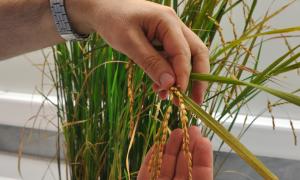Rice against HIV: a three-protein cocktail produced in seeds shows potent HIV neutralization in vitro

Rice components showed an enhancing effect, further helping to block HIV infectivity. Extracts could be used for the production of topical HIV microbicides to prevent sexual transmission of HIV. Microbicides might be implemented easily in low-income countries thanks to their low cost and ease of application.
Every year 1.8 million new HIV infections occur worldwide, mostly in Africa. In the absence of an efficient vaccine, research to stop the pandemic should not only focus on expanding anti-HIV treatments, but also on prevention to reduce the transmission of the virus. Topical microbicides might be an option in low income countries with difficult access to drugs and barrier methods such as condoms. In a paper published in the journal Proceedings of the National Academy of Sciences, researchers from the University of Lleida-Agrotecnio Center, IrsiCaixa AIDS Research Institute, and ICREA (Spain), The National Cancer Institute, Frederic, Maryland (USA) and Imperial College, London University (UK) report that three different proteins produced simultaneously in transgenic rice seeds are extremely effective in vitro against different strains of HIV-1, providing a new approach for the production of microbicidal gels that can be manufactured at a cost low enough for low income countries.
Some HIV infections can be eventually prevented by applying to the vagina or rectum microbicide gels containing anti-HIV drugs prior to intercourse. These drugs often block infection by binding to HIV proteins that play a key role in the virus entry in cells. However, traditional protein manufacturing platforms, usually based on mammalian cells and microbial systems, are too expensive and lack sufficient capacity for low income countries, which suffer the greatest disease burden. Therefore, alternative plant-based production strategies are an excellent alternative providing enhanced microbicidal activity.
Indeed, preliminary tests showed that rice components enhanced the three proteins in vitro binding to an HIV protein called gp120, which is necessary for the virus to invade human cells. Scientists also observed that rice proteins increased the potency of proteins against different HIV strains. “Therefore, the production of HIV-1 microbicides in rice may not only reduce costs compared to traditional platforms but may also provide functional benefits in terms of microbicidal potency,” explains Dr Julià Blanco, researcher from the Institut Germans Trias i Pujol at IrsiCaixa, where he leads the Cell Virology and Immunology group. Blanco highlights that “in some cases microbicides are the only option for women to prevent HIV-infection, as often men are reluctant to use condoms”. According to UNAIDS data, globally, young women are twice as likely to acquire HIV as their male counterparts.
“This groundbreaking new strategy is realistically the only way that microbicidal cocktails can be manufactured at a low cost enough for the countries more demanding of preventive HIV treatments –says lead researcher Dr Paul Christou, ICREA researcher at the University of Lleida-Agrotecnio Center –. And it provides a proof of the safety and utility of transgenic plants to cope with one of the most critical health issues worldwide”.
Multiple benefits as a microbicide production platform
Transgenic plants offer an alternative option benefiting from various advantages as a microbicide production platform. First of all, they have the ability to produce multiple components in a single plant, which is important because, as for standard antiretroviral therapy, an effective microbicide requires three or more components to avoid the rapid emergence of HIV strains resistant to drugs. Moreover, simultaneous expression of the three proteins in the same plant avoids the costs of multiple downstream processing processes.
Secondly, crude extracts can be used directly, avoiding the massive costs associated with purification of molecules produced in traditional platforms. Finally, cereal seeds are likely to be the most suitable platform for the production of microbicides in low income countries because the cultivation infrastructure is already in place and dry seeds can be stored indefinitely under ambient conditions.
